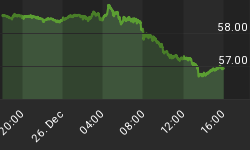Below is an excerpt from a commentary originally posted at www.speculative-investor.com on 14th February, 2010.
Inflation Update
The following monthly chart compares the year-over-year (YOY) growth rates of True Money Supply (TMS - the blue line) and M2 (the red line). As at the end of January the TMS yearly rate of change was down a few percent from its high, but was still well into double digits and in the top quartile of its 10-year range. The M2 rate of change, however, was at a 10-year low. As explained in previous commentaries, the large divergence over the past year between these two monetary aggregates is primarily due to declines in the NON-monetary components of M2 (the main non-monetary components of M2 being money-market funds and time deposits).

We have always been confident in the collective ability of the US Government and the Fed to perpetuate the inflation of the US money supply. The only question in our minds has been: how far will they be willing to go? The answer we have always come up with is that they will at least go as far as they can without causing interest rates to rocket upward. They may not go any further than that because monetary inflation becomes counterproductive -- from the perspective of a policymaker -- once the point is reached where interest rates are in a steep upward trend due to speculators anticipating the effects on the currency's purchasing power of future money-supply growth.
Another way of stating the above is that the US -- along with almost all other countries -- should experience inflation and nothing but inflation until the bond market "cries uncle". The inflation could conceivably continue beyond the point where bond prices begin to accelerate downward, but there is very little chance of it ending earlier than that. It won't end earlier because nobody outside of the relatively obscure "Austrian School" perceives a big problem with monetary inflation as long as the inflation isn't manifesting itself in sharply higher consumer prices and interest rates. In fact, many of the world's most influential economists believe that increasing the money supply can give a sustainable boost to a flagging economy, so persistent economic weakness over the years ahead will very likely prompt a steady stream of calls for more monetary profligacy (a.k.a. stimulus).
The Fed's "Exit Strategy"
It is generally easy to figure out what policymakers are going to do because they are working from 'playbooks' that describe very few plays. Bernanke's playbook, for instance, has a comprehensive list of all the problems that could beset the economy or the financial system, and for all except one of these problems the recommended 'play' is "cut interest rates and boost the money supply". For the lone exception the recommendation is "hike interest rates and reduce the money supply".
These days there are a lot of different ways that Bernanke can make his plays, but it always comes down to either reducing interest rates and boosting the money supply (Play 1) or hiking interest rates and reducing the money supply (Play 2). Having used Play 1 repeatedly since September of 2007, gingerly at first and then with gusto beginning in September of 2008, there is now a lot of discussion about a switch to Play 2. Whether Play 2 is achieved via an innovative policy tool (adjusting interest rates on bank reserves or selling securities to money-market funds, for example) or via a more traditional approach (using Open Market Operations to absorb excess bank reserves, for example) is not of great import. What is of great import is the extent to which Play 2 will actually be used.
The extent to which Play 2 gets used over the remainder of this year will largely be determined by what happens to the stock market, the real estate market, consumer prices and the T-Bond market. For example, if the equity bear returns then the Fed will almost certainly avoid Play 2 UNLESS consumer prices begin to rise rapidly and bond prices begin to fall rapidly. Moreover, if the equity bear doesn't return of its own accord then a Fed shift from Play 1 to Play 2 will almost certainly bring it back, prompting an almost immediate about-face on the Fed's part.
In summary, if there is a shift to Play 2 during 2010 it will likely be short-lived unless there happens to be a substantial increase in inflation fear. Therefore, the tightening of monetary policy is not something that gold investors need to be concerned about.
We aren't offering a free trial subscription at this time, but free samples of our work (excerpts from our regular commentaries) can be viewed at: http://www.speculative-investor.com/new/freesamples.html.
















